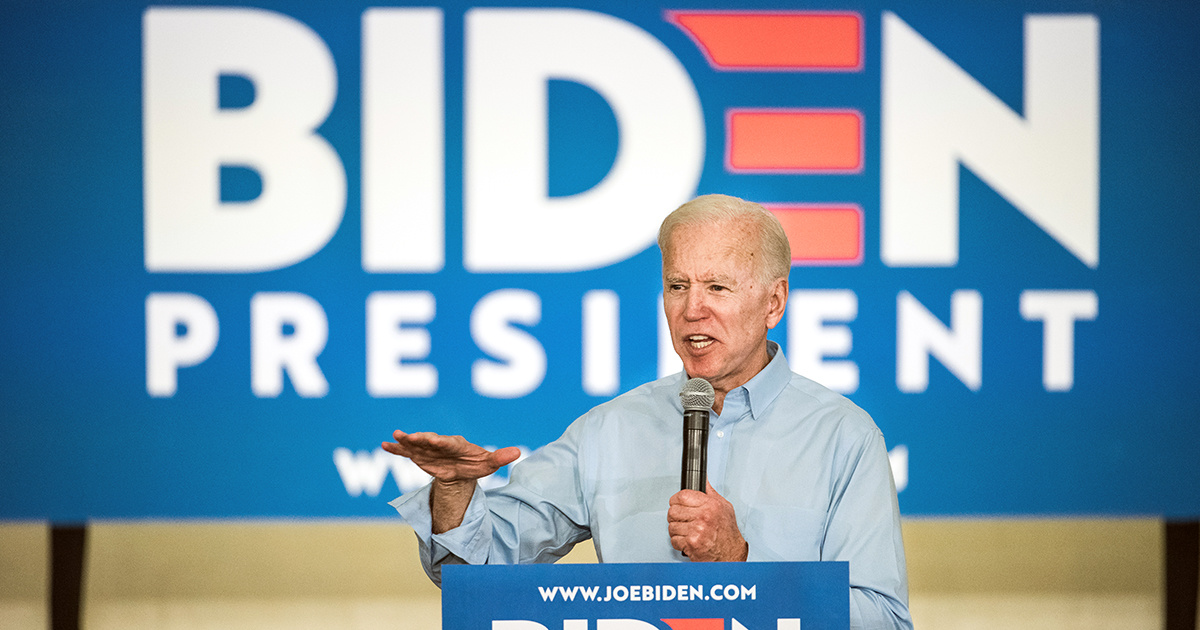
Biden’s Reported ‘Middle Ground’ Climate Policy Doesn’t Go Far Enough, Advocates Say

Democratic presidential candidate Joe Biden addresses a crowd at the Hyatt Park community center on May 4 in Columbia, South Carolina. Sean Rayford / Getty Images
Former Vice President Joe Biden has not released a detailed climate policy since he entered the Democratic presidential primary race a little more than two weeks ago. But two sources close to his campaign told Reuters Friday that he is crafting a policy that would serve as a “middle ground” between environmental advocates and blue-collar workers who voted for President Donald Trump.
That policy would include:
- Re-entering the Paris agreement.
- Preserving Obama-era emission and fuel efficiency regulations that the Trump administration is attempting to roll back.
- Supporting nuclear energy and fossil-fuel options like natural gas and carbon capture technology.
Scientists, environmental advocates and fellow primary contenders immediately criticized the plan as out of step with the most recent science on climate change, such as last October’s report from the Intergovernmental Panel on Climate Change (IPCC) that says global greenhouse gas emissions must fall by nearly half by 2030 years to avoid more than 1.5 degrees Celsius of warming above pre-industrial levels.
“Biden calls on physics, chemistry to meet him halfway,” 350.org Founder Bill McKibben responded in a tweet.
Interesting strategy: Biden calls on physics, chemistry to meet him halfway. Will be curious to see how they respondhttps://t.co/PzNQA2WFp3
— Bill McKibben (@billmckibben) May 10, 2019
Commentators noted that Biden’s plan amounted to restoring Obama-era climate policy after attacks by the Trump administration, but that climate science in the years since Obama left office had shown that policy to no longer be enough to meet the threat posed by climate change.
“Reheating the Obama administration’s regulations-plus-Paris approach will be totally insufficient,” climate scientist and Niskanen Center policy expert Joseph Majkut told The Huffington Post.
More than half of Biden’s primary opponents have backed a more ambitious Green New Deal to transition the U.S. from fossil fuels to renewable energy within 10 years while supporting green jobs and promoting equality, Reuters noted. Washington Gov. Jay Inslee, Vermont Sen. Bernie Sanders and New York Sen. Kirsten Gillibrand, all of whom back the Green New Deal, explicitly criticized Biden’s reported “middle ground” approach, The Huffington Post reported.
Inslee, who has focused his campaign primarily on fighting climate change, was the first to respond.
“[T]he times and science have changed. We cannot simply go back to the past; we need a bold climate plan for our future,” he said, according to Reuters.
Biden campaign spokesperson TJ Ducklo declined to comment to Reuters on the specifics of Biden’s forthcoming climate plan, but said the candidate had called climate change an “existential threat.”
In a Twitter thread Friday, Biden repeated the claim that climate change was an “existential threat.”
“We need policies that reflect this urgency. I’ll have more specifics on how America can lead on climate in the coming weeks,” he said.
We need policies that reflect this urgency. I'll have more specifics on how America can lead on climate in the coming weeks.
— Joe Biden (@JoeBiden) May 10, 2019
One of the sources Reuters drew on for its report, Heather Zichal, who advised Obama on climate and is now advising Biden, said the middle-of-the-road approach was based on her experience with the Obama administration.
“I respect where they (activist groups) are coming from,” Zichal told Reuters. “What we learned from the Obama administration is unless we find middle ground on these issues, we risk not having any policies.”
However, in a tweet Friday Zichal said that “Reuters got it wrong.”
I expect as president @JoeBiden would enact a bold policy to tackle climate change in a meaningful and lasting way,” she wrote.
I expect as president @JoeBiden would enact a bold policy to tackle climate change in a meaningful and lasting way. Reuters got it wrong. Any suggestion that it wouldn't is in direct contradiction to his long record of understanding climate change as an existential threat.
— Heather Zichal (@hrzichal) May 10, 2019
McKibben, in an op-ed for The Guardian, cast doubt on Zichal’s follow-up statement and her suitability as a climate adviser, saying that she had headed an inter-agency group during the Obama administration that focused on promoting domestic natural gas development. After leaving the administration in 2013, she joined the board of fracked gas exporter Cheniere Energy.
McKibben called on Biden to change course.
“If he’s going to mount a serious challenge to Trump, he’s going to need the huge number of Americans for whom climate change has become the issue. On the biggest issue our civilization’s ever faced, we need him thinking like it’s 2030, not 2010,” he wrote.
- Where Does 2020 Presidential Candidate Joe Biden Stand on the ...
- Biden-Harris Climate Plan: ‘Not Trump’ Is Not Enough

 233k
233k  41k
41k  Subscribe
Subscribe 